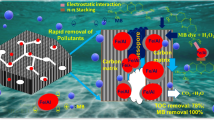Abstract
With the aim to obtain iron tubular microstructures attractive for various applications, we have used a natural biogenic iron ochre as a raw material and explore various procedures and experimental conditions to achieve our goal. Our experiments included reduction, nitridation and characterization of microtubes derived from biogenic iron ochre. Various temperatures of reduction under streams of H2/N2 or NH3 were tested. Our results show that the tubular structure is maintained after reduction of the natural material under H2/N2. In addition, ammonia was not produced under our experimental conditions, and as expected, hydrogen reduced the material. However, the treatment under NH3 reduces the material and allows the incorporation of nitrogen into the structure of the solid yielding iron nitride microtubes. Reduced and nitrided microstructures were successfully obtained from natural biogenic iron ochre. A temperature of 500 °C seems to be suitable to expose the calcined biogenic iron ochre under H2/N2 for 4 h or under ammonia for 8 h to obtain reduced or nitrided microtubes, respectively. The stability of the tubular structure during reduction/reduction–nitridation is maintained under both treatments. Further interesting applications of this natural biomaterial could be envisaged.




Similar content being viewed by others
References
Rentz J (2010) Phosphorus removal potential using biogenic iron oxides. WERF, USA
Ferris FG, Hallberg RO, Lyvén B, Pedersen K (2000) Retention of strontium, cesium, lead and uranium by bacterial iron oxides from a subterranean environment. Appl Geochem 15:1035–1042
Hargreaves JSJ, Alharthi AI (2016) Biogenic and bio-structured inorganic materials in heterogeneous catalysis: a brief overview. J Chem Technol Biotechnol 91:296–303
Alharthi AI, Blackley RA, Flowers TH, Hargreaves JSJ, Pulford ID, Wigzell J, Zhou W (2014) Iron ochre-a pre-catalyst for the cracking of methane. J Chem Technol Biotechnol 89:1317–1323
Hashimoto H, Itadani A, Kudoh T, Kuroda Y, Seno M, Kusano Y, Ikeda Y, Nakanishi M, Fujii T, Takada J (2013) Acidic amorphous silica prepared from iron oxide of bacterial origin. Appl Mater Interfaces 5:518–523
Mandai K, Korenaga T, Ema T, Sakai T, Furutani M, Hashimoto H, Takada J (2012) Biogenous iron oxide-immobilized palladium catalyst for the solvent-free Suzuki-Miyaura coupling reaction. Tetrahedron Lett 53:329–332
Shopska M, Paneva D, Kadinov G, Todorova S, Fabián M, Yordanova I, Cherkezova-Zheleva Z, Mitov I (2016) Composition and catalytic behavior in CO oxidation of biogenic iron-containing materials. React Kinet Mech Cat 118:179–198
Shopska MG, Kadinov GB, Briančin J, Yordanova ID, Kolev HG, Fabián M (2015) Preparation of Fe–Pd/Al–Si–O catalyst using biogenic iron of cultivated Leptothrix genus bacteria. Bulg Chem Commun Spec Issue C 47:79–86
Ema T, Miyazaki Y, Kozuki I, Sakai T, Hashimoto H, Takada J (2011) Highly active lipase immobilized on biogenous iron oxide via an organic bridging group: the dramatic effect of the immobilization support on enzymatic function. Green Chem 13:3187–3195
Ema T, Miyazaki Y, Taniguchi T, Takada J (2013) Robust porphyrin catalysts immobilized on biogenous iron oxide for the repetitive conversions of epoxides and CO2 into cyclic carbonates. Green Chem 15:2485–2492
Shopska MG, Cherkezova-Zheleva ZP, Paneva DG, Petkova V, Kadinov GB, Mitov IG (2014) Treatment of biogenic iron-containing materials. Croat Chem Acta 87(2):161–170
Jozwiak WK, Kaczmarek E, Maniecki TP, Ignaczak W, Maniukiewicz W (2007) Reduction behavior of iron oxides in hydrogen and carbon monoxide atmospheres. Appl Catal A Gen 326:17–27
Volpe L, Boudart M (1985) Compounds of molybdenum and tungsten with high specific surface area: I. Nitrides J Solid State Chem 59:332–347
Hashimoto H, Fujii T, Kohara S, Nakanishi K, Yogi Ch, Peterlik H, Nakanishi M, Takada J (2015) Structural transformations of heat-treated bacterial iron oxide. Mater Chem Phys 155:67–75
Darken L, Gurry R (1953) Physical chemistry of metals, vol 1953. McGraw-Hill, New York, p 374
Nishimaki K, Ohmae S, Yamamoto TA, Katsura M (1999) Formation of iron-nitride by reaction of iron nanoparticles with a stream of ammonia. Nanostruct Mater 12:527–530
Acknowledgements
The authors thank Mr. Gangi Reddy Ubarra for CHN analysis, and James and Christopher Hargreaves for collecting the iron ochre. In addition, JLR thanks CONACyT for the financial support received during his sabbatical period at the University of Glasgow, Scotland, UK.
Author information
Authors and Affiliations
Corresponding author
Ethics declarations
Conflict of interest
The authors confirm that they have no conflict of interest in relation to this study.
Rights and permissions
About this article
Cite this article
Rico, J.L., Hargreaves, J.S.J. Synthesis and characterization of iron and iron nitride microtubes obtained from biogenic iron oxide. J Mater Sci 52, 5188–5193 (2017). https://doi.org/10.1007/s10853-017-0759-5
Received:
Accepted:
Published:
Issue Date:
DOI: https://doi.org/10.1007/s10853-017-0759-5




